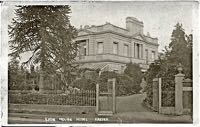
Crawford Hotel
Formerly Lion House - now a Co-op Convenience Store, 107 Alphington Road
Page added 8th January 2013
The Crawford Hotel was built in 1825 as a Georgian merchant’s mansion house. It was originally named Lion House. The earliest occupier of Lion House that can be found from the newspapers was a Mr Benjamin J Myers Esq, in 1856, an active member of Exeter's synagogue. He had moved in quite recently, for in 1854 he lived in Heavitree.
An article in the Flying Post of 1894, recounted an anecdote about Myer's son. The young man was said to be "mentally afflicted, but quite harmless and inoffensive". He enjoyed a walk and would sweep along wearing a long cloak. People would say "fine day, Mr. Myers," to which he would reply "I haven't tasted it yet." He would wear "course gipsy attire" and yet, he always liked to dine in evening dress.
Mr Benjamin Myers died at the age of 83, on the 4 February 1883, and a month later, his household furniture, horse, carriage and equipment were auctioned. The house was described in an April 1883 notice of sale in the Gazette.
"... with the coach-house, stable, and out-houses there to belonging, together with a walled garden behind, well stocked with fruit trees, and front garden, planted with ornamental shrubs, flowers, &c.
The house is of Classic design, the three main facades have handsome colonnades between the projecting wings, and contains–on the ground floor, handsome drawing room, 26ft. 6in. by 16ft. 4in., and 12ft. 6in. high, with three windows opening to a conservatory running the whole width of the house, a marble mantelpiece, fine cornice and centre flower; dining-room, breakfast-room, kitchens, scullery, pantry, and offices; spacious entrance hall, lobby, with ornamental carved ceiling; good staircase leading to corridor, upon which open onto four bedrooms and dressing-room, all light and lofty, with fireplace each. There are also two servants' bedrooms, approached by back staircase from the kitchen ; wine-cellar, coal-cellars, washhouse, with copper furnace; pump, with excellent supply of water.
In [an] enclosed yard at the side of the house are good coach house, man-servant's room, stables, hay-loft, wood-house, fowl-house, &c.
The property stands on one acre of ground, abutting on the turnpike-road, with good approach. The premises are substantially-built of stone, with spacious sub-basement...."
The sale went ahead on the 25 April, at the Queens Hotel, with Mr Fulford as auctioneer.
By 1884 the new owner was Morris Hart. There is little known of Morris Hart and his family over the ensuing years, apart from various adverts for servants. The house was for sale again in August 1892, and the next owner was Mr Henry Turner. His daughter was married in 1895, with the wedding reception held in the house.
Traction engine proprietor
The Gazette announced the sale of the house on 14 April 1904, due to the death of Mr Turner. The next to occupy the house was Henry Arden, a traction engine proprietor–however, had a short stay in the house. Just six months later Mr Henry Peter Channing was living in the house and standing as a Conservative for Cowick Ward. He briefly opened the house as a hotel during 1910, but the venture must not have been successful for Channing, as only about three adverts appeared in the local newspaper.
Channing remained at the house until it was sold on 26 June 1913 to Mr Charles Claridge. He was a timber merchant whose business had been well established at the canal basin, for at least a dozen years. By 1916 the house had been renamed, which was confirmed in an article in the Western Times about a flag day, in aid of Russia, which listed Crawford Lodge as one of the depots used to raise money–a total of £12 4s 7d was raised by ladies working from the lodge. Mr Claridge must have been a keen fisherman, for in 1921, he advertised several times for "... salmon fishing for one or two rods".
In July 1921, Claridge was prosecuted for having six stand-pipes attached to his water service pipe, contrary to regulations. He paid £1 per year for the use of a single hose in the garden, while the council had never had a case before of six stand-pipes. He was fined 40s. This case, along with several adverts for a gardener, suggest that the Lodge had a small, but well tended garden.
Becomes a hotel
In 1938, the City Council decided to purchase Crawford Lodge, and the adjacent land behind Omega Villas for the new cattle market. The intention was that the Lodge would be a hotel – however, Mr Claridge was not prepared to sell the house. The house and land was compulsorily purchased – the house was then offered to the breweries as a hotel, with the City Brewery, offering the highest price. It was converted into a hotel, which opened in October 1939 as "...the best equipped hotel of its size in the City".
Through the 1940s, and onwards, the hotel seems to have been popular for wedding receptions. In 1950, the propietor was another prospective Conservative councillor, this time for St Thomas, Mr Harold Hodgkinson. The road outside the hotel was the limit of the 1960 floods along the Alphington Road. In 1961, the hotel opened the Blue Room Lounge.
The hotel closed circa 2010, and remained boarded up, until 2013. The Crawford was purchased by the Southern Co-operative Society, and converted into a convenience store creating 14 jobs.
Source:Various Exeter newspapers.
│ Top of Page │

